Traction alopecia is a hair loss condition caused by constantly pulling on the hair. Eventually, this tension creates permanent damage to the hair follicles. Traction alopecia can occur in men and women of all ethnicities. But it is often seen in black females due to culturally tight hairstyles such as braids, ponytails, extensions, weaves, and cornrows. Even celebrities such as Jada Pinkett Smith have reported struggle with hair loss. After years of practicing harmful hair styling practices, this patient from Santa Monica, Los Angeles became a classic case for traction alopecia. After being referred by her hair stylist, she underwent a Dr.UPunch Curl™ hair transplant surgery as the best treatment for traction alopecia.
Best Traction Alopecia Treatment in Los Angeles by Dr. U
To learn more about this case, visit: https://dru.com/hair-surgery/black-female-experiences-the-dr-upunch-curl-as-the-best-treatment-for-traction-alopecia-sa…
Photos of Santa Monica Patient Before Her Bald Edges Treatment
Traction alopecia, also known as tension alopecia, or loss of hair edges as well as bald edges develops as thinning or empty margins around the sides of the scalp. These regions are also sometimes called “edges”.
The loss of edges is depicted in these patient photos before her surgery.
For a long time, she tried to cover the bare areas with longer sections of hair. But eventually, she decided on a more permanent solution by choosing a Dr.UPunch Curl™ FUE hair transplantation.
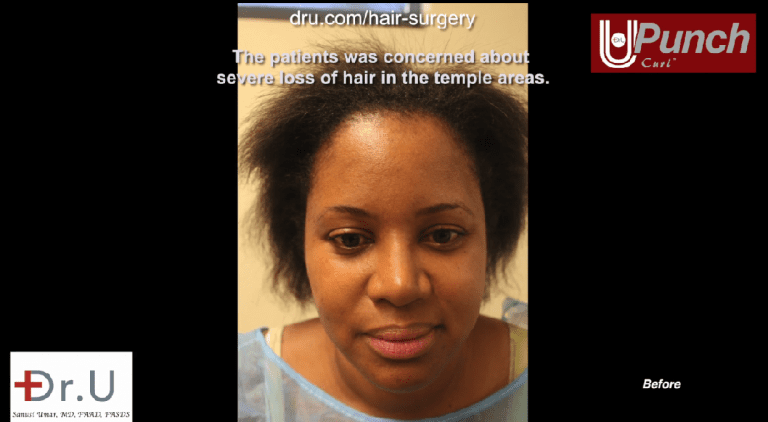
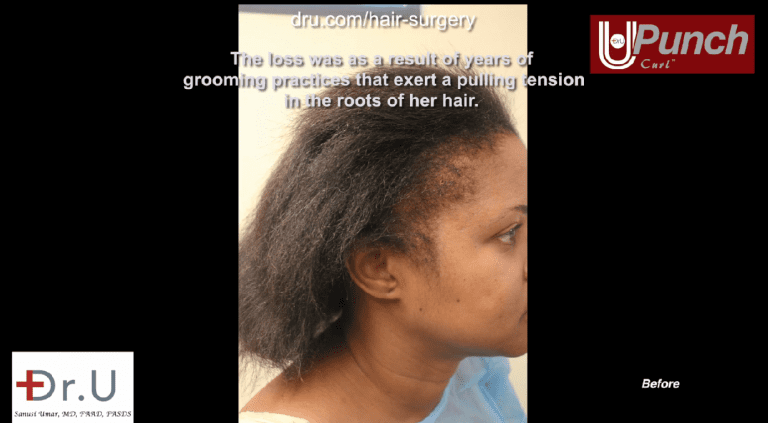
Procedure Photos of the Dr.UPunch Curl As the Best Treatment for Traction Alopecia
Hair restoration in women is only feasible if healthy donor follicles can be harvested. In most cases of female traction alopecia, surgery can offer the hope of renewed growth.
However, there has always been major barriers to performing successful hair transplants for African American patients. Like other ethnic groups, this demographic has two surgical methods to choose from.
The strip surgery technique uses a scalpel to remove the skin from the back of the head to derive donor grafts. However, it is not the best approach for African American women who are likely to develop large, raised keloid scars.
Follicular Unit Extraction is the other alternative. This hair transplant technique uses tiny punches to remove donor hair. General versions of these devices have a circular radially rotating cutting end, which works best on straight hair follicles. The curved grafts found in black patients is not very compatible with this basic design. Cylindrical punches struggle to follow the tortuous angle of growth, which results in transection of the graft.
According to Dr. Umar (also known as Dr. U) an even bigger challenge in performing FUE hair transplants on black patients lies in the thickness of their skin dermis layer. This thickness means the tissue attachments to follicular unit grafts are stronger.
Dr. Umar’s Method – Using the Dr.UGraft System for Black Female Hair Transplant
To solve these issues, Dr. Umar invented a highly specialized non-rotary punch called the Dr.UPunch Curl™. It is designed to cut around the curvature of black hair follicles. It can also penetrate even the thickest skin dermal tissue. In more challenging cases this device can be counted on as the best treatment for traction alopecia. This is due to the Dr.UPunch Curl’s sharp, two-pronged curved tip. Used with a plunging motion, this innovative punch follows the curves of tightly coiled hair follicles. Watch the animation below to see how it works.
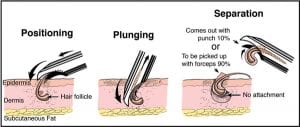
For some black patients, the blunt Dr.UPunch hybrid rotary punch is sufficient for removing curled follicles and penetrating the dermis. For other patients of African descent, this device may still produce higher transection rates. In such instances, the Dr.UPunch Curl™ should be used instead. This instrument can be used for all black patients to achieve very low transection rates of less than 10%.
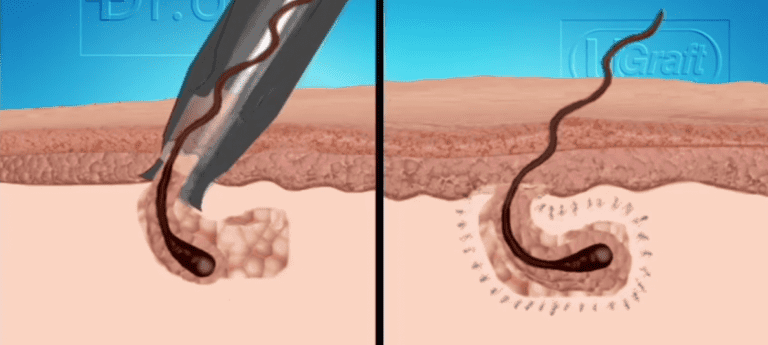
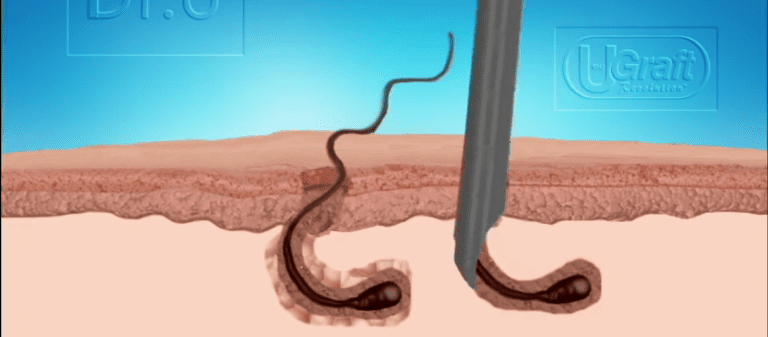
In this case of this female black patient, Dr. Umar first applied his rotary punch before switching to the Dr.UPunch Curl™
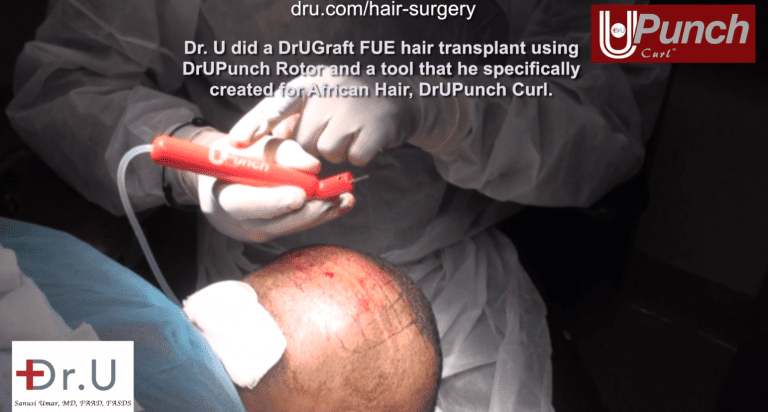
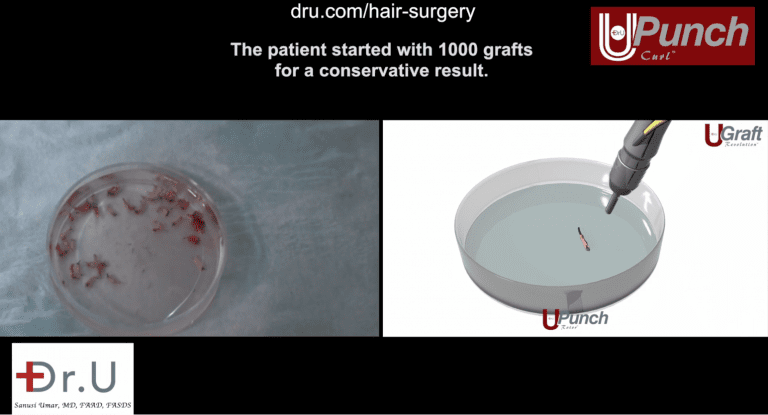
Black Female Hair Transplant Before and After Photos:
Here are photos of this patient before and after her hair transplant procedure, performed with the Dr.UPunch Curl ™. Dr. Umar used this technology to extract healthy hair follicles from the lower part of her scalp. He then inserted these grafts into the empty, thinning edges of the patient, around the sides of her head.
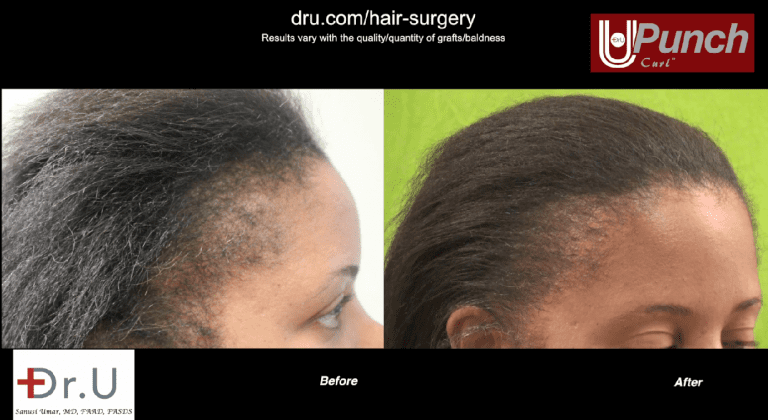
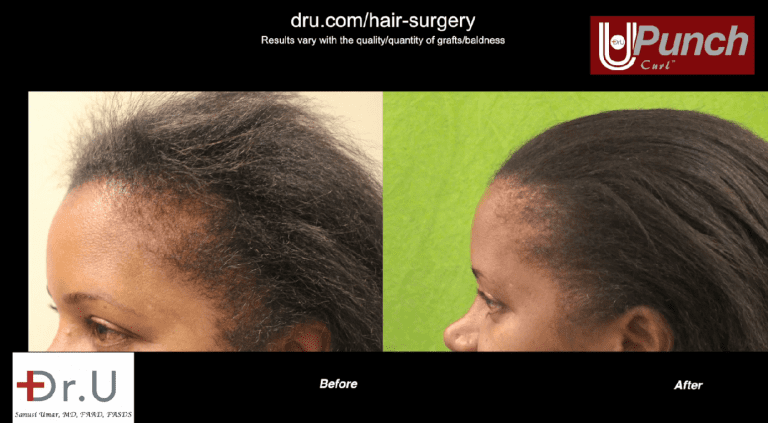

Video: Dr.UPunch Curl™ Achieves Traction Alopecia Regrowth For African American Patient
Watch this video of the patient’s procedure to learn more about her surgery and personal experience with traction alopecia.
To speak to Dr. Umar about choosing a surgical treatment for traction alopecia, click the button below to schedule a complimentary consultation.
Update September 2018: The patient above continued to see improve with her hair transplant results as her edge grew back in. Take a look at her updated results in the video below:
FAQ: Best Treatment for Traction Alopecia
Can traction alopecia be reversed?
Earlier signs of traction alopecia can easily be reversed. Individuals would simply have to change their hairstyles to stop the tension on their hair. This would also allow the hair follicles to heal and prevent permanent forms of hair loss. Topical application of minoxidil may also be effective in early stages of traction alopecia.
What are some ways I can grow my edges back from traction alopecia?
Hair transplant procedures can help with regrowth in advanced forms of traction alopecia. Earlier stages of TA will benefit from safer hair styling practices. The use of minoxidil can also help in the early stages of the condition.
When do I need to choose surgery for my traction alopecia treatment?
If hair cannot possibly regrow in the hair loss areas, then the follicles have been permanently damaged. In these situations, surgery will be the best way to transplant new follicles in order to see improvement.
Have more questions about the best treatment for traction alopecia? Use the “Ask Dr. U” button below to send your inquiry.
Further Reading – Surgical Bald Edges Treatment
Meet a male black patient who underwent a Dr.UPunch Curl™ hair transplant


